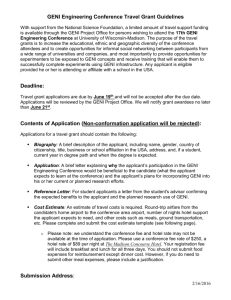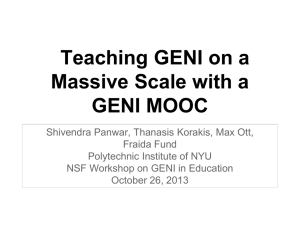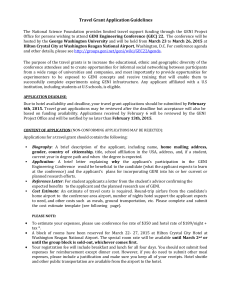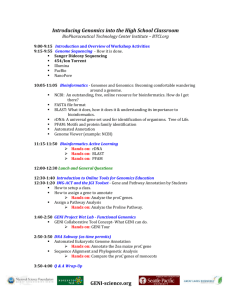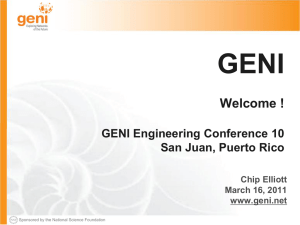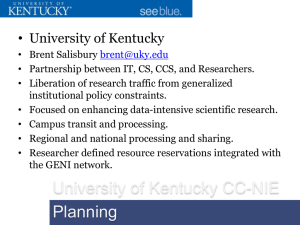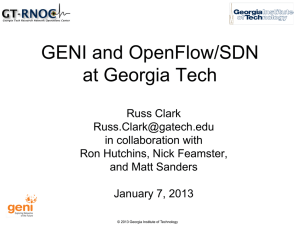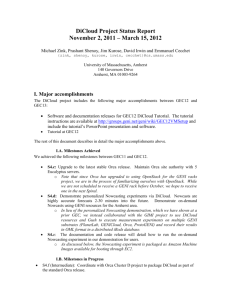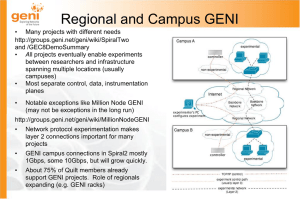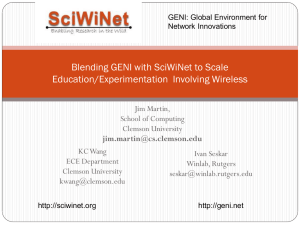Virtual Laboratories
advertisement
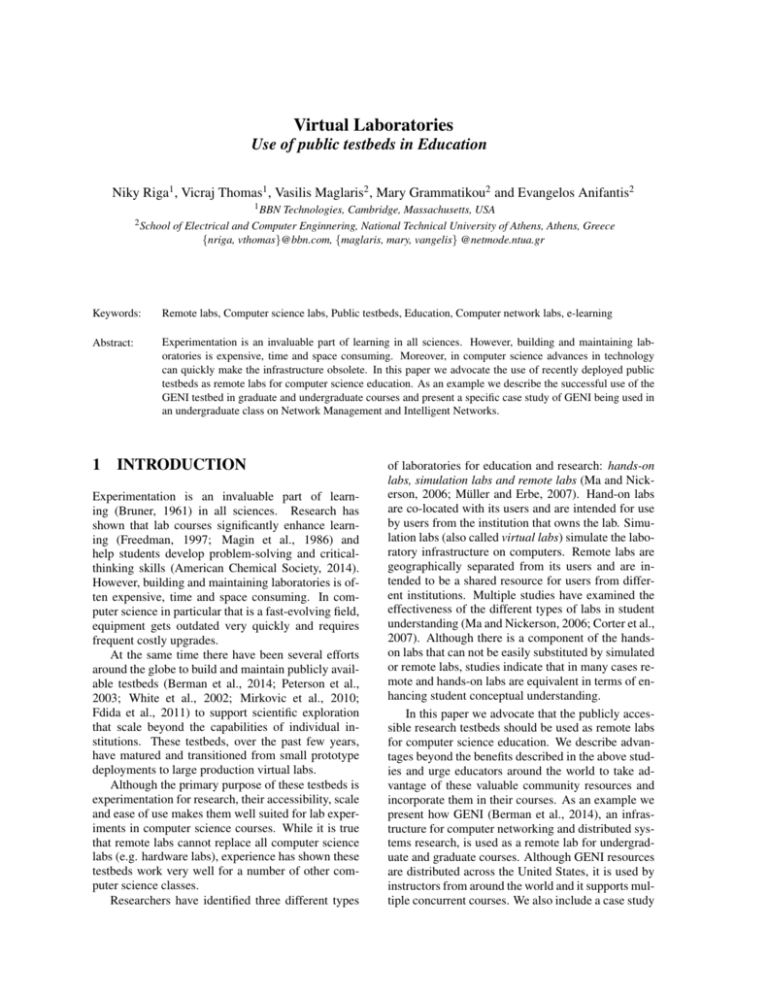
Virtual Laboratories
Use of public testbeds in Education
Niky Riga1 , Vicraj Thomas1 , Vasilis Maglaris2 , Mary Grammatikou2 and Evangelos Anifantis2
1 BBN
2 School
Technologies, Cambridge, Massachusetts, USA
of Electrical and Computer Enginnering, National Technical University of Athens, Athens, Greece
{nriga, vthomas}@bbn.com, {maglaris, mary, vangelis} @netmode.ntua.gr
Keywords:
Remote labs, Computer science labs, Public testbeds, Education, Computer network labs, e-learning
Abstract:
Experimentation is an invaluable part of learning in all sciences. However, building and maintaining laboratories is expensive, time and space consuming. Moreover, in computer science advances in technology
can quickly make the infrastructure obsolete. In this paper we advocate the use of recently deployed public
testbeds as remote labs for computer science education. As an example we describe the successful use of the
GENI testbed in graduate and undergraduate courses and present a specific case study of GENI being used in
an undergraduate class on Network Management and Intelligent Networks.
1
INTRODUCTION
Experimentation is an invaluable part of learning (Bruner, 1961) in all sciences. Research has
shown that lab courses significantly enhance learning (Freedman, 1997; Magin et al., 1986) and
help students develop problem-solving and criticalthinking skills (American Chemical Society, 2014).
However, building and maintaining laboratories is often expensive, time and space consuming. In computer science in particular that is a fast-evolving field,
equipment gets outdated very quickly and requires
frequent costly upgrades.
At the same time there have been several efforts
around the globe to build and maintain publicly available testbeds (Berman et al., 2014; Peterson et al.,
2003; White et al., 2002; Mirkovic et al., 2010;
Fdida et al., 2011) to support scientific exploration
that scale beyond the capabilities of individual institutions. These testbeds, over the past few years,
have matured and transitioned from small prototype
deployments to large production virtual labs.
Although the primary purpose of these testbeds is
experimentation for research, their accessibility, scale
and ease of use makes them well suited for lab experiments in computer science courses. While it is true
that remote labs cannot replace all computer science
labs (e.g. hardware labs), experience has shown these
testbeds work very well for a number of other computer science classes.
Researchers have identified three different types
of laboratories for education and research: hands-on
labs, simulation labs and remote labs (Ma and Nickerson, 2006; Müller and Erbe, 2007). Hand-on labs
are co-located with its users and are intended for use
by users from the institution that owns the lab. Simulation labs (also called virtual labs) simulate the laboratory infrastructure on computers. Remote labs are
geographically separated from its users and are intended to be a shared resource for users from different institutions. Multiple studies have examined the
effectiveness of the different types of labs in student
understanding (Ma and Nickerson, 2006; Corter et al.,
2007). Although there is a component of the handson labs that can not be easily substituted by simulated
or remote labs, studies indicate that in many cases remote and hands-on labs are equivalent in terms of enhancing student conceptual understanding.
In this paper we advocate that the publicly accessible research testbeds should be used as remote labs
for computer science education. We describe advantages beyond the benefits described in the above studies and urge educators around the world to take advantage of these valuable community resources and
incorporate them in their courses. As an example we
present how GENI (Berman et al., 2014), an infrastructure for computer networking and distributed systems research, is used as a remote lab for undergraduate and graduate courses. Although GENI resources
are distributed across the United States, it is used by
instructors from around the world and it supports multiple concurrent courses. We also include a case study
based on the use of GENI by the “Network Management and Intelligent Networks” class at the National
Technical University of Athens.
2
RESEARCH TESTBEDS AS
REMOTE LABS FOR
EDUCATION
In this section we expand on our position that educators will reap great benefits if they take advantage
of public testbeds being built for research, in their
classes. We advocate the use of these testbeds over
institution-specific hands-on labs and present a list of
benefits for instructors and students.
We also describe a specific research testbed for
networking and distributed systems research, GENI,
and present why it has gained traction among educators as a remote lab in the past few years.
2.1
Educational Benefits of Research
Testbeds
In most cases educators are better off using remote
labs over setting up their own hands-on labs. Handson labs put a high demand on space, instructor time
and experimental infrastructure (Ma and Nickerson,
2006). The experimental infrastructure can be expensive to acquire, set up and administer. Additionally,
advances in technology can quickly make the infrastructure obsolete.
An alternative to building local hands-on labs is
to use remote labs. While a few remote labs such as
(IBM News Release, 2007; Obstfeld et al., 2014) have
been built primarily for education many large testbeds
with substantial community support are being built
for research. Benefits of leveraging these testbeds as
remote labs include:
• Accessibility. Research testbeds are designed for
use by researchers from around the globe. They
are available around the clock and accessible by
students from anywhere they have Internet connectivity. Global accessibility also enables innovative teaching methodologies such as crossinstitutional student project teams.
• Access to unique or expensive resources. Research testbeds often include resources and equipment that would ordinarily not be affordable for
educational purposes. Students however can have
access to these resources if the testbed is used as
a remote lab.
• State-of-the-art resources. To facilitate cuttingedge research, these testbeds are frequently updated with state-of-the-art resources. This allows
students to be exposed to latest technology, without the burden to the institution to maintain up-todate local labs.
• Number of resources. Many of the research
testbeds have orders of magnitude more resources
than is realistically possible in a typical hands-on
lab. This make it possible for instructors to assign lab exercises that require more resources than
were previously practicable. This is particularly
beneficial for classes in cloud computing and data
sciences.
• Community support and ease of use. Shared public testbeds build a community of users that develops an maintain a variety of tools to enable easy
experimentation, and researchers spend more time
addressing research related problems than making
the testbed do what they want. Moreover educators using a research testbed as a remote lab, form
their own community that creates a pool of common and up-to-date resources (e.g. lab assignments).
• Preparing students for research. Students who are
exposed to research testbeds during their coursework are better prepared to use them for their research.
2.2 GENI: A Laboratory for Research
and Education
GENI (Global Environment for Network Innovations)
is a laboratory for networking and distributed systems
research (Berman et al., 2014). It consists of compute and networking resources distributed across the
United States. Researchers can reserve compute resources and connect them in Layer 2 topologies that
are best suited to their experiments.
Although GENI is a research infrastructure, it has
been used extensively in graduate and undergraduate classes as a remote lab by institutions around the
world ( Figure 1).
GENI is a sliced testbed i.e. multiple researchers
can run concurrent experiments in isolated slices of
the testbed, without functionally interfering with one
another (Figure 2). The sliceability of GENI makes
it an ideal platform for running classes since multiple students can create virtual topologies on the same
infrastructure and multiple labs can run concurrently
without interfering with one another or with users
running experiments for their research.
ware (Marasevic et al., 2013; Griffioen et al.,
2013; GENI Project Office, 2014).
• GENI supports collaborative experimentation. In
the context of education this enables collaboration
between instructor and students and collaborative
team projects.
Figure 1: Number of students trained each semster using
GENI.
Figure 2: Multiple users can concurrently use GENI in isolated virtual topologies.
Other than its multi-user properties, GENI is a
great example of a research testbed that is suitable for
education because:
• It is deeply programmable and allows its users
to setup, modify, and study network protocols.
GENI is suitable for teaching a wide range of networking concepts. It has been used to teach the
basics of IP routing and TCP congestion management as well as supported deployment of custom
routing algorithms.
• GENI includes unique resources that allows its
users to setup interesting experiments. For example:
– Software Defined Networking resources.
GENI achieves deep network programmability
by deploying programmable network devices
(e.g. OpenFlow switches) in the core of the network.
– WiMAX base stations. GENI has deployed
and virtualized several WiMAX base stations
that can be used remotely for wireless experimentation.
• There is a community of instructors that
have developed and shared GENI-based course
• GENI is designed to support cutting-edge networking research and thus has safe-guards in
place to protect the infrastructure from faulty experiments. Additionally, since experimentation is
often a process of trial and error, GENI makes it
easy for a researcher to terminate an experiment
and start over. GENI is therefore a safe environment for students to experiment and start over
when necessary, without the need for instructor or
administrator intervention.
• GENI employs a single sign-on mechanism that
provides easy access to students by simply using their institution login information. This is
achieved through InCommon (InCommon, 2014),
a US federation based on Shibboleth (Morgan
et al., 2004) authentication mechanism. Shibboleth is very popular among educational institution around the world, making it straightforward
to provide access to international institutions not
members of InCommon.
GENI is not the only publicly available research
testbed. Over the past decade several testbeds have
been created to facilitate experimentation. Examples
of such testbeds include Emulab (White et al., 2002)
for networking research, Deter (Mirkovic et al., 2010)
for security research, ORBIT (Raychaudhuri et al.,
2005) for wireless experimentation, PlanetLab (Peterson et al., 2003) for distributed, peer-to-peer research,
OFELIA (Su et al., 2014) for programmable network
research, okeanos (Koukis and Louridas, 2013) and,
FIRE (Vandenberghe et al., 2013). Although these
testbeds are primarily intended to be used for scientific exploration, they have been successfully used as
remote laboratories (Wong, 2012; PlanetLab, 2009).
Most of these testbeds are either federated or share
common APIs with GENI, forming a large ecosystem
at the disposal of educators.
3 CASE STUDY
The GENI infrastructure was used for two consecutive years within the laboratory exercises that supplement our 5th year undergraduate course on Network
Management Intelligent Networks at the Electrical &
Computer Engineering School of the National Technical University of Athens (NTUA), Greece (NET-
MODE, 2015) The main objectives of the lab exercises were to provide students with hands-on experience regarding the reservation, interconnection and
usability of dispersed and heterogeneous virtualized
resources.
The students in the role of experimenters were
asked to create slices, design network topologies and
reserve GENI resources at several locations such as
Stanford University and the Georgia Institute of Technology. Moreover, students were called to explore
the networking capabilities provided by GENI infrastructure. For that, they deployed (i) GRE tunnels
to achieve connectivity among resources at different locations and (ii) virtual machines running Open
vSwitch acting as Layer 2 software switches connecting the hosts (VMs) in each island.
Overall, 72 users joined the GENI project which
was created for the networking class. Amongst them,
68 undergraduate students in 49 groups (comprised
of one or two students) were asked to create one slice
per group and run their own experiment following the
exercise instructions (Figure 3). For the completion
of the exercise assignment, 343 VMs were spawned,
98 local networks were created at different sites hosting GENI resources and 49 multi-domain networks
were formed. As a result, a significant number of
simultaneous users deployed virtual slices across the
Atlantic, pushing GENI capabilities to higher levels
and indicating feasibility of sharing educational labs
across the globe.
Experimenters (students) were provided with the
GENI Experimenter’s guide along with step-by-step
instructions for slice creation via GENI-provided GUI
tools. Subsequently, they were called to document
their experience by filling in a questionnaire on the
following items:
1. Overall GENI service experience: 87% of the
students noted a good understanding the GENI
service functionality and 92% declared that they
were satisfied by it.
2. Resource creation/deletion: Approximately 74%
were satisfied with the reservation procedure.
This was highly dependent on students choice of
site where the resources were created. Also although 83% of the students encountered difficulties the first time they tried to setup their experiment, 70% of them where able to overcome their
problem without help from the instructors and
start over.
3. Resources availability and accessibility: 35% had
difficulties in the process of resource reservation.
This might be partially attributed to students oversubscribing for popular GENI resources.
It is worth noting that a staggeringly high percentage of students, 97.5%, declared that the integration
of remote labs (not just GENI) in education could advance significantly the quality of their studies.
Moreover the instructors of the class found the
role-based membership of GENI projects very valuable. By assigning administrative privileges to the lab
instructors, it enabled remote assistance and debugging from anywhere and anytime in response to students inquiries.
4 Benefits in a nutshell
Leveraging public research testbeds, such as
GENI, in education yields multifold advantages for
both students and educators. Students have the opportunity to work in a collaborative environment
and join an active worldwide community engaged
in shaping the Future Internet era. Besides the exercise assignments, students experience in practice
how dispersed and heterogeneous compute resources
can be remotely reserved, controlled and orchestrated
through open source tools towards establishing ondemand networking experiments. In fact, in our study
at NTUA, 92% of the students declared their eagerness for continuing using GENI for research purposes
in the future.
Educators using large scale research infrastructure with unique, otherwise unaffordable, resources
and user-friendly tools are able to provide students in
advanced networking courses with experiences they
would not otherwise have. The geographically dispersed remote labs provide also the opportunity to
surpass the geographical barriers by reproducing experiments in different locations and offering to the
students a better understanding of how Internet works
in reality. For instance, students at NTUA used
testbeds to learn how an inter-autonomous system
routing policy can enforce global internet traffic.
5 CONCLUSIONS
Technological advances in information technology
have radically changed not only our everyday lives
but have also transformed education and learning possibilities. They have enhanced the old-school handson laboratories where students and infrastructure need
to be collocated, with simulated and remote labs (Ma
and Nickerson, 2006; Müller and Erbe, 2007).
Recently several publicly availbale testbeds for
computer science research have been built and made
available to the research community. In this paper we
Figure 3: Lab Experiment using GENI Infrastructure at NTUA
argue that these testbeds should be adopted by educators as the platform of choice for developing course
modules for computer science cources. There are
great benefits to the educators and the students not the
least of which are: no need to buy, build and maintain
infrastructure, access to unique resources, being part
of a community that actively develops and enhances
new modules.
Education is moving towards a model of continuous, online learning where the norm will be for students to be remote. We believe that we are going to
see an increase in use of remote and virtualized labs.
These large scale public testbeds are not only suitable
as remote labs for traditional classes but are also ideal
for online courses and as a platform for Massive Open
Online Courses (MOOC).
REFERENCES
American Chemical Society (2014).
Importance of
hands-on laboratory science.
http://www.acs.
org/content/acs/en/policy/publicpolicies/
.
Public
invest/computersimulations.html
Policy Statement 2014-2017.
Berman, M., Chase, J. S., Landweber, L., Nakao, A., Ott,
M., Raychaudhuri, D., Ricci, R., and Seskar, I. (2014).
GENI: A federated testbed for innovative network experiments. Computer Networks, 61(0):5 – 23. Special
issue on Future Internet Testbeds Part I.
Bruner, J. S. (1961). The act of discovery. Harvard Educational Review, 31(1):21–32.
Corter, J. E., Nickerson, J. V., Esche, S. K., Chassapis, C.,
Im, S., and Ma, J. (2007). Constructing reality: A
study of remote, hands-on, and simulated laboratories.
ACM Trans. Comput.-Hum. Interact., 14(2).
Fdida, S., Wilander, J., Friedman, T., Gavras, A., Navarro,
L., Boniface, M., MacKeith, S., Avéssta, S., and Potts,
M. (2011). FIRE Roadmap Report 1 Part II, Future
Internet Research and Experimentation (FIRE).
Freedman, M. P. (1997). Relationship among laboratory
instruction, attitude toward science, and achievement
in science knowledge. Journal of Research in Science
Teaching, 34(4):343–357.
GENI Project Office (2014). Resources for instructors using GENI. http://groups.geni.net/geni/wiki/
GENIEducation .
Griffioen, J., Fei, Z., Nasir, H., Wu, X., Reed, J., and Carpenter, C. (2013). GENI-enabled programming experiments for networking classes. In Proceedings of the
2013 Second GENI Research and Educational Experiment Workshop, GREE ’13, pages 111–118, Washington, DC, USA. IEEE Computer Society.
IBM News Release (2007). Google and IBM announce university initiative. http://www-03.ibm.com/press/
us/en/pressrelease/22414.wss
.
InCommon (2014). Incommon. http://www.incommon.
org .
Koukis, E. and Louridas, P. (2013). okeanos iaas. In EGI
Community Forum 2012 / EMI Second Technical Conference, Proceedings of Science, Munich, Germany.
Ma, J. and Nickerson, J. V. (2006). Hands-on, simulated,
and remote laboratories: A comparative literature review. ACM Computing Surveys, 38(3).
Magin, D. J., Churches, A. E., and Reizes, J. A. (1986). Design and experimentation in undergraduate mechanical engineering. In Proceedings of a Conference on
Teaching Engineering Designers.
Marasevic, J., Janak, J., Schulzrinne, H., and Zussman, G.
(2013). Wimax in the classroom: Designing a cellular
networking hands-on lab. In Proceedings of the 2013
Second GENI Research and Educational Experiment
Workshop, GREE ’13, pages 104–110, Washington,
DC, USA. IEEE Computer Society.
Mirkovic, J., Benzel, T., Faber, T., Braden, R., Wroclawski,
J., and Schwab, S. (2010). The deter project: Advancing the science of cyber security experimentation and
test. In Technologies for Homeland Security (HST),
2010 IEEE International Conference on, pages 1–7.
Morgan, R. L., Cantor, S., Carmody, S., Hoehn, W.,
and Klingenstein, K. (2004). Federated Security:
The Shibboleth Approach. EDUCAUSE Quarterly,
27(4):12–17.
Müller, D. and Erbe, H. (2007). Advances on Remote
Laboratories and E-Learning Experiences, chapter 2,
pages 35–59. Number 6 in Engineering. Deusto Publicaciones.
NETMODE (2015). Courses offered by the netmode ntua
lab. http://www.netmode.ntua.gr/main/index.
php?option=com\_content\&view=article\&id=
22\&Itemid=36 .
Obstfeld, J., Knight, S., Kern, E., Wang, Q. S., Bryan, T.,
and Bourque, D. (2014). VIRL: The virtual internet
routing lab. In Proceedings of the SIGCOMM 2014
Conference.
Peterson, L., Anderson, T., Culler, D., and Roscoe, T.
(2003). A blueprint for introducing disruptive technology into the internet. SIGCOMM Comput. Commun.
Rev., 33(1):59–64.
PlanetLab (2009). Planetlab courseware. https://www.
planet-lab.org/courseware
.
Raychaudhuri, D., Seskar, I., Ott, M., Ganu, S., Ramachandran, K., Kremo, H., Siracusa, R., Liu, H., and Singh,
M. (2005). Overview of the ORBIT radio grid testbed
for evaluation of next-generation wireless network
protocols. In Wireless Communications and Networking Conference, 2005 IEEE, volume 3, pages 1664–
1669 Vol. 3.
Su, M., Bergesio, L., Woesner, H., Rothe, T., Kpsel, A.,
Colle, D., Puype, B., Simeonidou, D., Nejabati, R.,
Channegowda, M., Kind, M., Dietz, T., Autenrieth,
A., Kotronis, V., Salvadori, E., Salsano, S., Krner, M.,
and Sharma, S. (2014). Design and implementation
of the OFELIA FP7 facility: The European OpenFlow
testbed. Computer Networks, 61(0):132 – 150. Special
issue on Future Internet Testbeds Part I.
Vandenberghe, W., Vermeulen, B., Demeester, P., Willner,
A., Papavassiliou, S., Gavras, A., Sioutis, M., Quereilhac, A., Al-Hazmi, Y., Lobillo, F., Schreiner, F., Velayos, C., Vico-Oton, A., Androulidakis, G., Papagianni, C., Ntofon, O., and Boniface, M. (2013). Architecture for the heterogeneous federation of future
internet experimentation facilities. In Future Network
and Mobile Summit (FutureNetworkSummit), pages
1–11. IEEE.
White, B., Lepreau, J., Stoller, L., Ricci, R., Guruprasad,
S., Newbold, M., Hibler, M., Barb, C., and Joglekar,
A. (2002). An integrated experimental environment
for distributed systems and networks. SIGOPS Oper.
Syst. Rev., 36(SI):255–270.
Wong, G. (2012). ProtoGENI and undergraduate courses.
http://dept.cs.williams.edu/
˜ jeannie/
nsf-workshop/slides/gary.pdf
.
